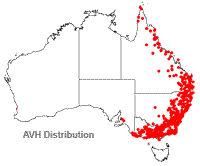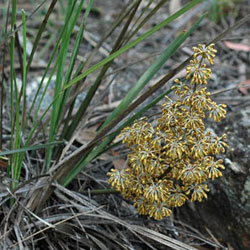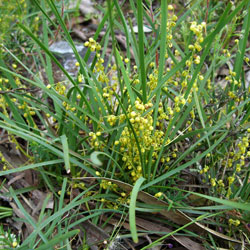Lomandra filiformis
Wattle Mat-rush
Lomandra filiformis (Thunb.) Britten
Lomandra filiformis, whose common name is Wattle Mat Rush, is native to Australia. According to the Australian Plant Index, this species belongs to the Asparagaceae family but can also be found listed in the Lomandraceae and Xanthorrhoeaceae families.
 It is widespread in eastern Australia, from northern Queensland through New South Wales to Victoria as far west as the Grampians. This species is generally found growing in open forest and woodland areas and will tolerate much drier conditions than Lomandra longifolia [GNP page]. It performs in a variety of soil types from heavy clays to, humus-rich and sandy soils.
It is widespread in eastern Australia, from northern Queensland through New South Wales to Victoria as far west as the Grampians. This species is generally found growing in open forest and woodland areas and will tolerate much drier conditions than Lomandra longifolia [GNP page]. It performs in a variety of soil types from heavy clays to, humus-rich and sandy soils.
It is a compact perennial herb growing up to 50cm tall in sparse clumps up to 20cm in diameter with a semi-arching habit. The leaves are stiff, approximately 3mm to 5mm in width, with inrolled margins and are dull green to bluish-green in colour. Each leaf is tipped with one to three tiny light brown points. This plant spreads by underground creeping rhizomes and when affected by fire will re-establish from these.
This species becomes noticeable at flowering time - mainly from October to November, but this may vary according to locality. The flowers are cream to bright yellow, hence the common name. The male flowers are ball shaped, up to 2mm in length, while the female flowers are more tubular, up to 3mm in length.
This plant grows well in full sun or part shade and can tolerate a range of temperatures from extreme highs to lows. It is exceptionally drought hardy and tolerant to frost.
Lomandra filiformis can be propagated by either seed or division.
Seeds disperse quickly making collection difficult. To perform well, seeds need to be sown directly after collection. Soaking seeds in warm water 24 hours prior to sowing will help break their dormancy. Their germination rate is low and they can take between 4 to 12 weeks or even longer to emerge.
An established plant can be divided but ensure roots are attached to each section before planting. Each new plant can be planted directly into the garden or into a pot.
This is a low maintenance plant but may require occasional pruning to remove tattered ends. It is not subject to any known pests and diseases. Once established this species requires very little to no irrigation, making it a low water use plant.
Both stunning and versatile, this species can be used for mass plantings in garden beds and borders. It is particularly useful in small gardens and courtyards as a design feature and can be planted to complement native grasses. As it is slow growing this makes it ideal as a container plant.
Text by Val Cheater (2009 Botanical Intern)
Name Meaning: Lomandra filiformisLomandra – from the Greek Loma – meaning edge or border – and aner – man or male – because of the borders on the anthers of some species. filiformis – threadlike, referring to the narrow leaves. |
References
Australia’s Virtual Herbarium (AVH) (2009). Council of Heads of Australian Herbaria (CHAH). Available at http://www.cpbr.gov.au/chah/avh/index.html.
Fethers, S. (2009) Australian National Botanical Gardens, Canberra. Personal communication.
George, A.S. (Ed.) (1986) Flora of Australia Volume 46, Iridaceae to Dioscoreaceae. Australian Government Publishing Service, Canberra.
Jones, D. & Jones, B. (1999) Native Plants of Melbourne and Adjoining Areas. Bloomings Books, Hawthorn Victoria.
Quirico, A.L. (1993). Lomandra filiformis (Thunb.) Britten in PlantNET - The Plant Information Network System of Botanic Gardens Trust, Sydney, Australia (Version 2.0). Available at http://plantnet.rbgsyd.nsw.gov.au/cgi-bin/NSWfl.pl?page=nswfl&lvl=sp&name=Lomandra~filiformis
Saunders, W.G. (2009) Director, Seeds and Plants Australia Pty Limited, Canberra. Personal communication.
Stanley, T. & Ross, E. (1989) Flora of South-eastern Queensland Volume 3. Queensland Department of Primary and Industry.
Taylor, D. (2009) Australian National Botanical Gardens, Canberra. Personal communication.
Walsh, N. & Entwisle, T. (1994) Flora of Victoria Volume 2, Ferns and Allied Plants, Conifers and Monocotyledons. Inkata Press.
![An Australian Government Initiative [logo]](/images/austgovt_brown_90px.gif)



